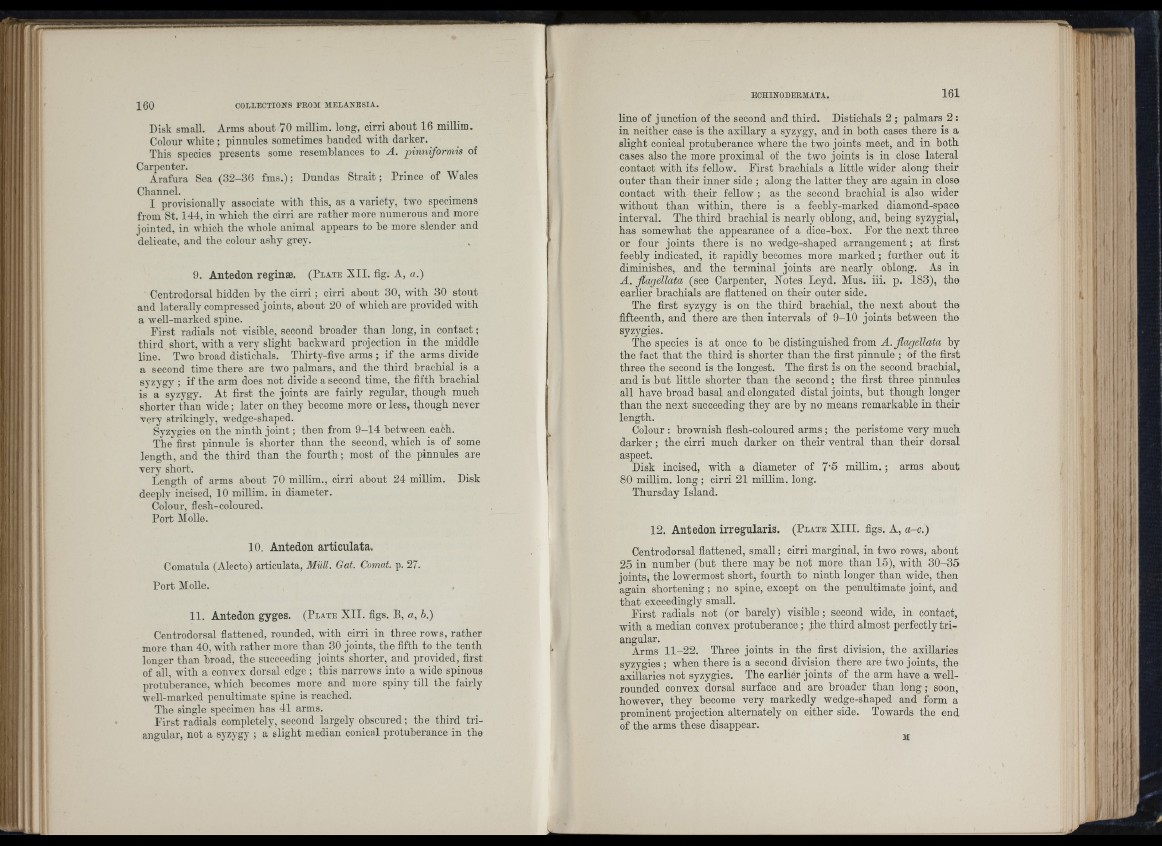
160
I Í
Disk small. Arms about 70 miUim. long, cirri about 16 millim.
Colour white ; pinnules sometimes banded with darker.
This species presents some resemblances to A . pinniformis of
Carpenter.
Arafura Sea (32-36 fms.); Dundas S tra it; Prince of Wales
Channel.
I provisionally associate with this, as a variety, two specimens
from St. 144, in which the cirri are rather more numerous and more
jointed, in which the whole animal appears to he more slender and
delicate, and the colour ashy grey.
9. Antedon reginse. (P la te X II. fig. A, a.)
Centrodorsal hidden by the c ir r i; cirri about 30, with 30 stout
and laterally compressed joints, about 20 of which are provided with
a well-marked spine.
First radials not visible, second broader than long, in co n ta c t;
third short, with a very slight backward projection in the middle
line. Two broad distichals. Thirty-five arms ; if the arms divide
a second time there are two palmars, and the third brachial is a
syzygy ; if the arm does not divide a second time, the fifth brachial
is a syzygy. At first the joints are fairly regular, though much
shorter than wide; later on they become more or less, though never
very strikingly, wedge-shaped.
Syzygies on the ninth jo in t ; then from 9 -14 between each.
The first pinnule is shorter than the second, which is of some
length, and the third than the fo u rth ; most of the pinnules are
very short.
Length of arms about 70 millim., cirri about 24 millim. Disk
deeply incised, 10 millim. in diameter.
Colour, flesh-coloured.
Port Molle.
10. Antedon articulata.
Comatula (Alecto) articulata, MiilL Gat. Comat. p. 27.
Port Molle.
11. Antedon gyges. (P la te X II. figs. B, a, h.)
Centrodorsal flattened, rounded, with cirri in three rows, rather
more than 40, with rather more than 30 joints, the fifth to the tenth
longer than broad, the succeeding joints shorter, and provided, first
of all, with a convex dorsal edge ; this narrows into a wide spinous
protuberance, which becomes more and more spiny till the fairly
well-marked penultimate spine is reached.
The single specimen has 41 arms.
Ihrst radials completely, second largely obscured; the third triangular,
not a syzygy ; a slight median conical protuberance in the
line of junction of the second and third. Distichals 2 ; palmars 2 ;
in neither case is the axillary a syzygy, and in both cases there is a
slight conical protuberance where the two joints meet, and in both
cases also the more proximal of the two joints is in close lateral
contact with its fellow. First brachials a little wider along their
outer than their inner sid e ; along the latter they are again in close
contact with their fellow; as the second brachial is also wider
without th an within, there is a feebly-marked diamond-space
interval. The third brachial is nearly oblong, and, being syzygial,
has somewhat the appearance of a dice-box. For the n ext three
or four joints there is no wedge-shaped arrangement; a t first
feebly indicated, it rapidly becomes more marked; further out it
diminishes, and the terminal joints are nearly oblong. As in
A . fiagellata (see Carpenter, Notes Leyd. Mus. iii. p. 183), the
earlier brachials are flattened on their outer side.
The first syzygy is on the third brachial, the n ex t about the
fifteenth, and there are then intervals of 9-10 joints between the
syzygies.
The species is at once to be distinguished from A. fiagellata by
the fact th at the third is shorter than the first p in n u le ; of the first
three the second is the longest. The first is on the second brachial,
and is h u t little shorter than the second; the first three pinnules
all have broad basal and elongated distal joints, but though longer
than the next succeeding they are by no means remarkable in their
length.
Colour : brownish flesh-coloured arms ; the peristome very much
d a rk e r; the cirri much darker on their ventral than their dorsal
aspect.
Disk incised, with a diameter of 7'5 millim.; arms about
80 millim. lo n g ; cirri 21 millim. long.
Thursday Island.
12. Antedon irregularis. (P la te X I I I. figs. A, a-e.)
Centrodorsal flattened, small; cirri marginal, in two rows, about
25 in number (hut there may be not more than 15), with 30-35
joints, the lowermost short, fourth to ninth longer than wide, then
again shortening; no spine, except on the penultimate joint, and
th a t exceedingly small.
First radials not (or barely) visible; second wide, in contact,
with a median convex protuberance; the third almost perfectly tr iangular.
Arms 11-22. Three joints in the first division, the axillaries
syzygies ; when there is a second division there are two joints, the
axillaries not syzygies. The earlier joints of the arm have a well-
rounded convex dorsal surface and are broader than lo n g ; soon,
however, they become very markedly wedge-shaped and form a
prominent projection alternately on either side. Towards the end
of the arms these disappear.
M
' >r
!■ ' ‘ I> S •